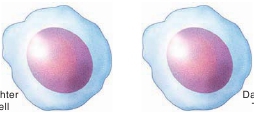808
PART 4 Regulation and Maintenance

Cytotoxic T Cells
Cytotoxic T cells
have two main effects: (1) they lyse cells and(2) they produce cytokines (figure 22.23). Cytotoxic T cells cancome into contact with other cells and cause them to lyse. Virus-infected cells have viral antigens, tumor cells have tumor antigens,and tissue transplants have foreign antigens on their surfaces thatcan stimulate cytotoxic T-cell activity. A cytotoxic T cell binds toa target cell and releases chemicals that cause the target cell tolyse. The major method of lysis involves a protein called
perforin,
which is similar to the complement protein C9 (see figure 22.10).Perforin released by cytotoxic T cells forms a channel in theplasma membrane of the target cell. Water enters the cell throughthe channel, causing the cell to swell and lyse. The cytotoxic T cellthen moves on to destroy additional target cells.In addition to lysing cells, cytotoxic T cells release cytokinesthat activate additional components of the immune system. Forexample, one important function of cytokines is the recruitment ofcells, such as macrophages. These cells are then responsible forphagocytosis and inflammation.
ASSESS
YOUR PROGRESS
53.
What type of lymphocyte is responsible for cell-mediatedimmunity? What are the functions of cell-mediatedimmunity?
54.
How do intracellular microorganisms stimulate cytotoxicT cells? What role do helper T cells play in this process?
55.
State the two main responses of cytotoxic T cells.
56.
How is long-lasting immunity achieved in cell-mediatedimmunity?
22.6
Acquired Adaptive Immunity
LEARNING OUTCOME

After reading this section, you should be able to
A.
Explain the four ways that adaptive immunity can beacquired.
Predict 7
In patients with acquired immunodeficiency syndrome (AIDS), theHIV virus infects and destroys helper T cells. Patients often die ofpneumonia caused by an intracellular fungus (
Pneumocystis carinii
) or ofKaposi sarcoma, which is characterized by tumorous growths in the skinand lymph nodes. Explain what is happening.
Unlike innate immunity, adaptive immunity is not necessarily pres-ent at birth. Instead, adaptive immunity must be acquired. Adaptiveimmunity can be broken down into four types, based on the way it isacquired: active natural, active artificial, passive natural, and passiveartificial (figure 22.24).
Active immunity
results when an individualis exposed to an antigen (either naturally or artificially) and theresponse of the individual’s immune system is the cause of theimmunity.
Passive immunity
occurs when another person or ananimal develops immunity and the immunity is transferred to a
1
An MHC class I molecule displaysan antigen, such as a viral protein,on the surface of a target cell.
1
MHC class Imolecule
2
Processedantigen
T-cellreceptor

2
The activation of a cytotoxic T cellbegins when the T- cell receptorbinds to the MHC class I/antigencomplex.
3
3
There is costimulation of thecytotoxic T cell by CD8 andother surface molecules.
4
There is costimulation bycytokines, such as interleukin-2,released from helper T cells.
5

5
The activated cytotoxic T celldivides, the resulting daughtercells divide, and so on,eventually producing manycytotoxic T cells (only two areshown here).
DaughterT cell
DaughterT cell

PROCESS FIGURE 22.22
Proliferation of Cytotoxic T Cells